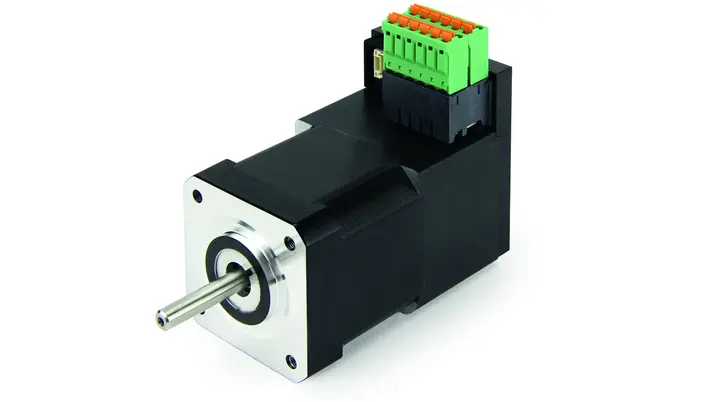Stepper motors have more than one string to their bow
Textile manufacturing processes often require numerous individual components. Individually reliable and accurate sensor / actuator technology for textile machines is very expensive, which hinders widespread use. To improve functionality and quality, economical industrial solutions are needed. For this purpose, a research team created textile-inspired production technology solutions with electric motors from Nanotec.
Complex components made of fiber-reinforced plastics (FRP), such as node structures for car bodies and aircraft construction, are of great use to industries. Here, manufacturers braid around cores using radial or axial braiding machines with braiding yarns.
To create high-strength, rigid components, extra warp yarns are added to reinforce the biaxial braid in the axial direction. The triaxial braid thus created is consolidated, say, with epoxy resin and then uncored – for use in FRP lightweight applications.
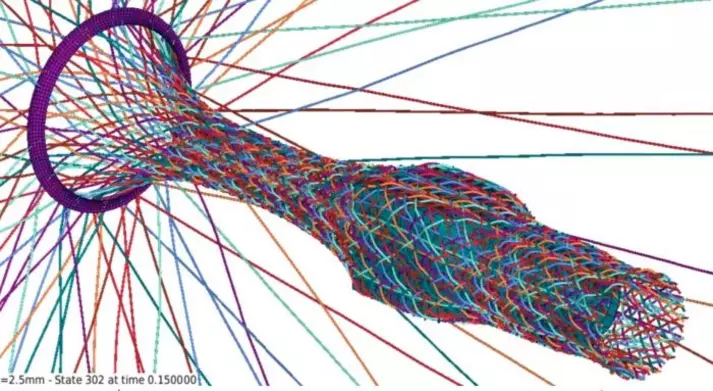
Textile motor technology required
The German Institutes of Textile and Fiber Research (DITF) in Denkendorf, founded in 1921, are a public-law foundation under the authority of Baden-Württemberg's economy-and-finance ministry. With around 250 employees in scientific and technical roles, the largest textile research center in Europe is a global leader in its field.
During the publicly subsidized cooperative industrial research (IGF) project 19679N, the DITF developed solutions including a new yarn brake and equipped a widely available braiding machine with 72 individual warp-yarn tensile-force controllers. The project ran from September 1, 2017, to February 29, 2020.
Stepper motors instead of brush sparking
For cost reasons, the braiding machine was initially equipped with a brushed DC motor with gearbox per warp yarn. But when controlling the warp yarn tension, the conventional carbon brush motors produced too much heat, did not allow precise adjustment of the yarn tensile force, and the fluctuations, and showed too much deviation from the set value. When operating at a low speed or when at a stand-still under torque load, the motors overheated until the brushes sparked and failed.
"Brush dust and gearbox self-locking were also serious problems. We needed to significantly reduce friction, heat and drive losses," says Hermann Finckh, Head of Numeric Simulation at DITF. Therefore, Finckh's team developed an unusual alternative. The technology used included:
- Radial braiding machine RF 1/144-100 (from Herzog, with components from Steeger)
- Controller from Beckhoff with OptiBraid software developed in-house
- Standard finite element software LS-DYNA for process simulation
- Braiding simulation software Fast Analytical Virtual Braiding (FAV Braiding) developed in-house
- 72 stepper motors PD2-C4118L1804-E-08 with integrated CANopen controller and single-turn absolute encoder from Nanotec
Triaxial braids with new possibilities: Thanks to a closed-loop stepper motor
Every individual stepper motor with single-turn absolute encoder has a resolution of 4096 pulses per revolution. Using torque, it adjusts the tension of "its" individual warp yarn as soon as the tension deviates from the set value. As a result of the closed-loop operation, the stepper motor provides a lot of torque and holding torque even at low speeds and when at a standstill, thereby slowing down the warp yarns safely and reliably. The load tolerance is also high.
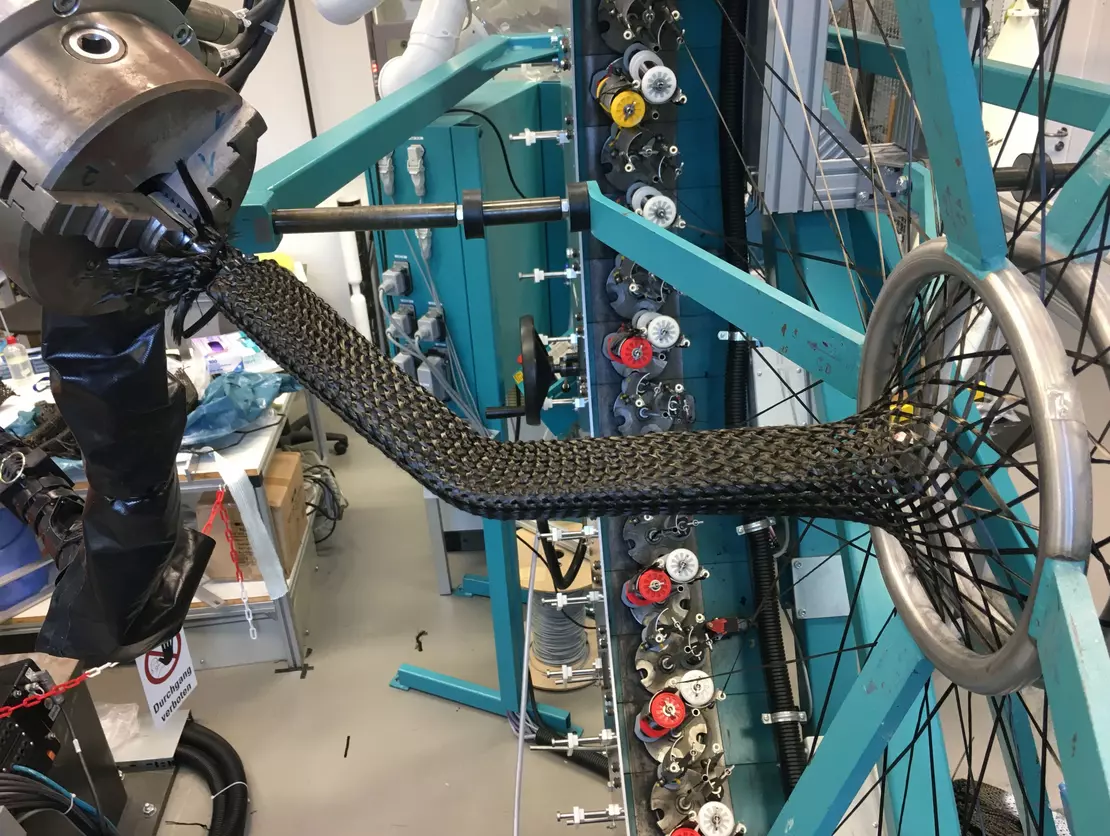
"Closed-loop stepper motors only draw power when they need it," explains Finckh. "They produce less heat, run smoother and with less resonance than normal steppers. They also provide position feedback and control, short settling and decay times and show no step loss."
The process with a stepper-motorized warp yarn brake helps to adjust the yarn tension precisely, even for days of correct tension, without any significant motor heat or fluctuations. Moreover, the newly developed system also pulls back the braiding yarns with the constant torque, as required by the system during braiding.
And: Closed-loop stepper motors can tense warp yarns so precisely that the braiding yarns fit even more closely to the component contour.
Fig. 4: Prominently bent component contour. ©DITF
Fig. 5: Braid far from contour, in poor elbow shape, due to incorrectly adjusted warp yarn tension. ©DITF
Fig. 6: Tightly contoured braid, in a much more precise elbow shape, also thanks to closed-loop stepper motors controlling the warp yarn tensile force. ©DITF
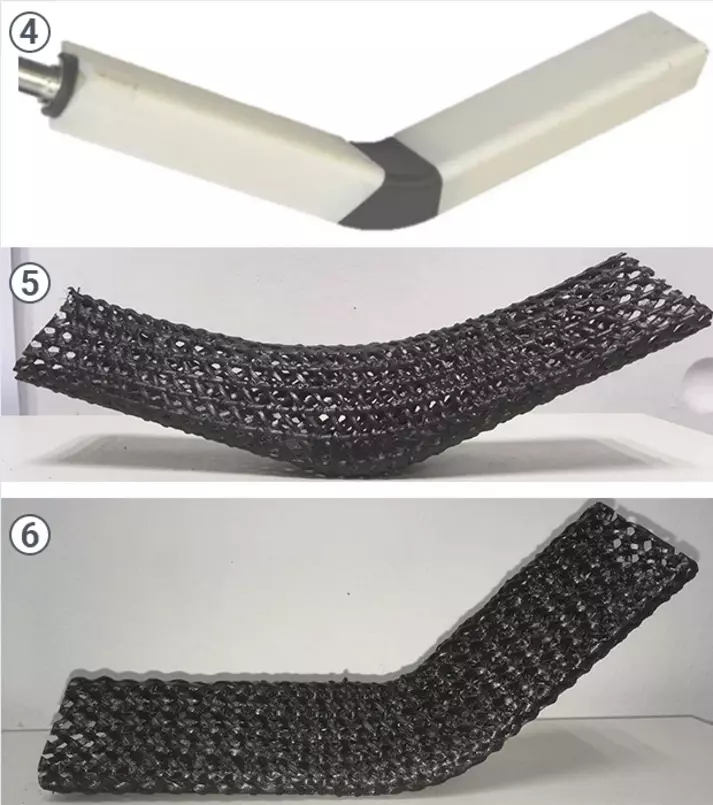
Timely yarn tensile force for each motor
The challenge already arose in the motor control system – and the need to switch all 72 motors on / off individually in real time, plus to specify and query the motor parameters. By a graphical user interface (GUI) that had yet to be developed, all relevant parameters – such as the yarn tensile force (torque) for each motor – needed to be adjusted unambiguously and documented with motor precision. Via interface, the optimal yarn tensile force adjustment for each motor can now be transmitted at the right time (depending on the braiding core's current position). These braiding-core-dependent warp yarn tensile forces will be determined via a braiding simulation and provided as a file.
"The CAN-in-CAN-out looping for 72 stepper motors was complex. Using a PLC real-time bus controller from Beckhoff, and because each stepper had its own controller, we were ultimately able to loop all 72 motors to meet all the requirements," says project leader Finckh. Mechanical operation also demanded a lot from the motors. It was particularly important to the developers that low yarn tensile forces are precisely and constantly maintained even at standstill.
Winding, warping, weaving – quick and defined
The converted braiding machine and its automated motor technology are a prototype for the fur-ther optimization of production. The newly developed yarn braking principle – electric motors brake the yarns and keep them under tension – is primarily also suitable for all textile processes where yarns are unwound under a defined tension at different speeds, winding, warping, weaving, etc. Thus, the system is also to be used for future research projects and optimized application-wise.
As stepper motors, individually controlled by CAN bus, carry out all motion quickly and in a defined way, they are especially well suited for optimized and new textile production processes. In combined weaving and braiding applications, the IGF project 3D Weave-Braid promotes the use of stepper motors to influence textile binding structures and create new economical production methods.
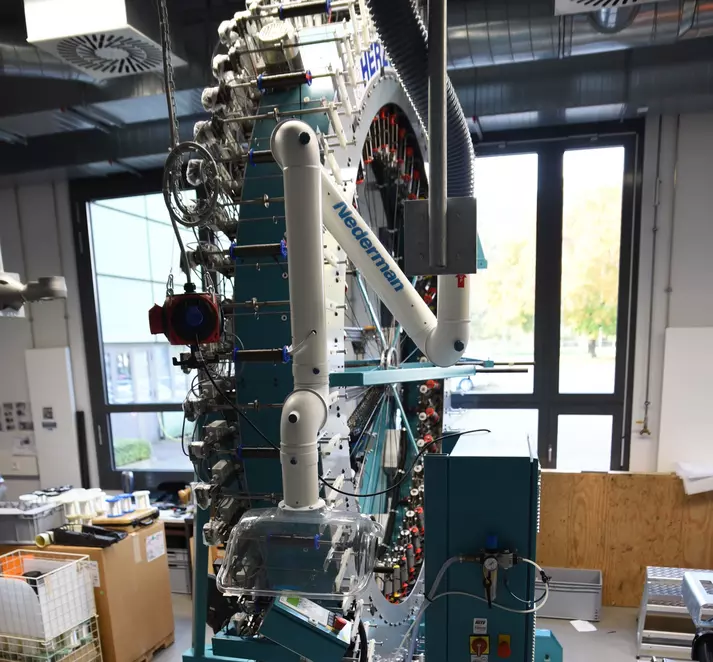
Project for small and medium-sized enterprises and more
Now, despite their complexity, individual braids can be produced much faster than before – as a first step away from preforms with long-distance logistics, say, from abroad. The new technologies are equally suitable for both radial and axial braiding machines in all fiber composite technology. They allow small and medium-sized enterprises to develop and produce lightweight, high-performance products and, in terms of Industry 4.0, provide a basis for end-to-end digital process chains and applications.
Hermann Finckh, Head of Simulation Research, German Institutes for Textile and Fiber Research DITF
Dr. Karsten Düsdieker, Technical Editor, Nanotec Electronic GmbH & Co. KG

